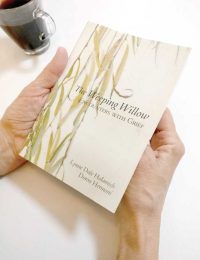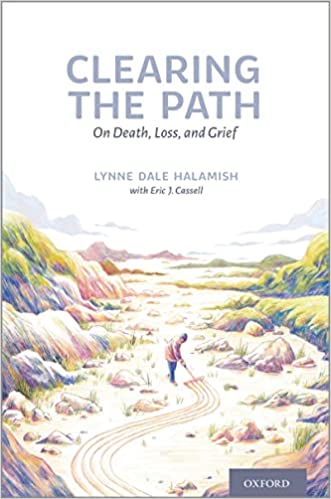Clearing the Path: On Death, Loss and Grief
Written 13 years after its companion volume The Weeping Willow, the book brings even more complex encounters and nuanced emotions from additional years of experience in the field. The stories are woven in with the counseling process, thought process, and dilemmas of the counselor. Each story is then followed by “Notes to the Practitioner” with clear, practical and professional advice on navigating various communication issues and end with “Conclusions” which are short summaries of each vignette’s teachings. At the end of each chapter the reader will find recent, annotated references for those who wish to read more about the topic.
Amazon Book Review:
Jennifer gives the book 5 stars and writes:
A Wonderful Read
Clearing the Path is Lynne Dale Halamish’s second book. Halamish is a grief counselor practicing in Israel, and a globe-trotting lecturer, teaching medical professionals worldwide how to deal with the grief of their patients and their patients’ loved ones.
While Clearing the Path is technically a textbook, teaching both how to deal with grieving souls and how to deal with grief when it strikes us, it is also a gripping read. Each chapter is another interesting narrative related as actual conversations with patients and the people around them. The tales gently grip the audience. This book brings to mind the Simon and Garfunkel song The Dangling Conversation and the line “And we note our place with book markers. That measure what we’ve lost”. This book ends much too quickly.
At the end of each chapter the reader finds “Notes to the Practitioner” and “Conclusions”. These explain what happened during the counseling, signs to look for, the meaning of the signs and other information to clarify the chapter. There are also recommended readings for those who want to delve deeper into the clinical aspects of dealing with grief. All in all, this is an excellent read. I enjoyed every minute.
The Weeping Willow
The Weeping Willow: Encounters with Grief is a collection of true stories about death, dying and grieving. It includes field experiences and is based on knowledge from many sources. The target audience is the comforter as well as the griever, not necessarily the professional, although every professional, if he lives long enough, will eventually become the griever.
The distinguishing features of this book are brevity and directness. The model is laser surgery; each story focuses on very few points, preferring clarity to mass. The goal is to provide practical tools for the griever and/or the comforter or professional. If there is no practical approach to the specific dilemma, you will not find a story about it in this book.
The book works on three levels: Clinical stories, Brief theoretical Background, and Tools at a glance. Our premise is: theory is not enough, tools are not enough, stories are not enough, but together they can flesh out and make useful instruments for the reader. Each story or chapter in the book contains a vignette along with the teaching that can be gleaned from it. The stories are brief (one to three pages) and so is the teaching. The work is designed to be a handbook, offering guidelines to assist the reader in times of personal grief or the grief of those near him/her both personally and professionally. Each teaching contains two to four tools for dealing with death.
Many types of grief are addressed between the covers of The Weeping Willow, from the lingering bleakness of slow gradual death, to the disorienting trauma of sudden unexpected death, terrorist bombing, suicide, the death of a spouse, grandparents, parents, children, siblings.
The Weeping Willow is not meant to replace counseling, rather it is an addition to the arsenal of counseling. It is also, on some level, a ´call to order´ to counselors, other professionals and friends who have not been trained for grief counseling and are using impractical or erroneous methods.
This book is also meant to provide some assistance to those who would not otherwise get counseling or where grief counseling is unavailable. It is meant to normalize normal grief responses – reassure the grievers and those around them that they are not “crazy” for experiencing a less understood but valid aspect of grief.
The tools you will find in The Weeping Willow are not the only tools known, there are other effective tools in the field of grief counseling. The Weeping Willow gleaned tools from the field, which have been tested, and work well. Our advice to the reader is; “If it works for you, use it. If it doesn’t, throw it away.” No reservations, no sentiment, be practical.
Do not lose yourself in the field whether that field is professional or family and friends. Every meeting between two people is two worlds colliding, sometimes roughly, and sometimes with a gentle nudge. Although you may use the tools in this book, do not ignore yourself when you do so. Be present as who you are. A tool needs to be appropriate to the person using it, or at least to part of the personality. Take chances. There will never be enough tools to deal with death.
Buy the Book

The Weeping Willow
ENCOUNTERS WITH GRIEF
is available in English via Amazon.com
and Hebrew from the author
via PayPal
We will ship the Hebrew version of the book only within Israel. If you wish to receive it outside of Israel, please contact us via email so we can calculate the shipping charge for your country.
If you prefer to send a check for the book, email us and send us your shipping details. After we receive the check, we will ship the book to you.
Скоро на русском языке
A Russian version is soon to be released.
I leave you with the blessing of Jonathan Swift:
“May you live every day of your life.”
1. Why did you decide to publish a book?
For years people have been asking me to write articles or a book on grief. It seemed like a good idea, so that the valuable things I am learning in the field will not be lost when I die.
The certainty of death is understood. Dying is as common a human experience as being born. Yet we react to talk of someone´s approaching death as though it were abnormal. This reveals the taboo which makes the book useful.
2. Who is your book written for?
The Weeping Willow: Encounters with Grief is being used by many professionals, but the target audience is actually the griever. The Weeping Willow is a handbook to empower the griever with practical tools for coping with grief. The book is arranged for easy location of advice on specific dilemmas in death, dying and grieving. The language is down-to-earth and the anecdotes are real cases from my files, retold with all their original human drama. Each story is followed by a few clinical references for the benefit of professionals. The cases presented in the book had all identifying characteristics of counselees changed, and permission was obtained prior to use of the stories.
By Francie Scott, LCSW (Chicago, Illinois)
I read this book from the perspective of a practicing social worker and also as a parent who has experienced the death of a child. This book provides clear and practical insights for understanding and working with grief. The true stories are poignant, concise and portray lessons and “truths” that could take a lifetime of professional practice to learn. From each story the author is able to distill practical advice and show how and why the advice matters, for those who want the theory; there are plenty of footnotes to pursue further research.
But not only is this book a valuable tool for professional counselors, the life stories and lessons touch on universal experiences we all face learning to live with the loss of parents, siblings, children or a traumatic event. The lessons in this book serves as navigational aids for all who find themselves in these turbulent and unsettling waters.
I will be buying this book for colleagues, and for those just beginning their careers in the helping professions.
By Kate Grundy (Palliative Medicine Physician and Clinical Director)
This 189-page soft-covered booked addresses a topic that impacts on all professionals working within the healthcare field. The format of the book is one of its major assets, breaking down the subject into small chapters with a unique clinical focus. Early on in the book is a “grief map” which highlights each issue, the people for whom this aspect may be relevant for (i.e. children, teenagers, siblings, parents, etc.) and the relevant chapters where this is covered. Each chapter has a narrative section that is clinically-based and illustrates the subject matter beautifully. This is followed each time with a conclusion which is bulleted and then by key references.
The book covers the full spectrum of grief scenarios including children, teenagers, suicide, religion, rituals, and the importance of body language. This means that the book is truly one that can be picked up and used to guide care at the specific time that is it needed. More importantly, however, the book can and will be read from cover to cover as a remarkably composed account of the diversity of grief and how with understanding we can positively influence the experience for those who are bereaved.
This book is an absolute gem. The 30 real-life stories are taken from the author´s personal experience in counselling individuals and families, and the human context is ever present. The stories are brief and utterly compelling. One reviewer describes the book as “an elixir of distilled wisdom for anyone who seeks to help someone who is grieving”.
This book is thoroughly recommended.
Kate Grundy
Palliative Medicine Physician and Clinical Director
Christchurch Hospital Palliative Care Service
Christchurch
(Additional reviews can be found on Amazon)
